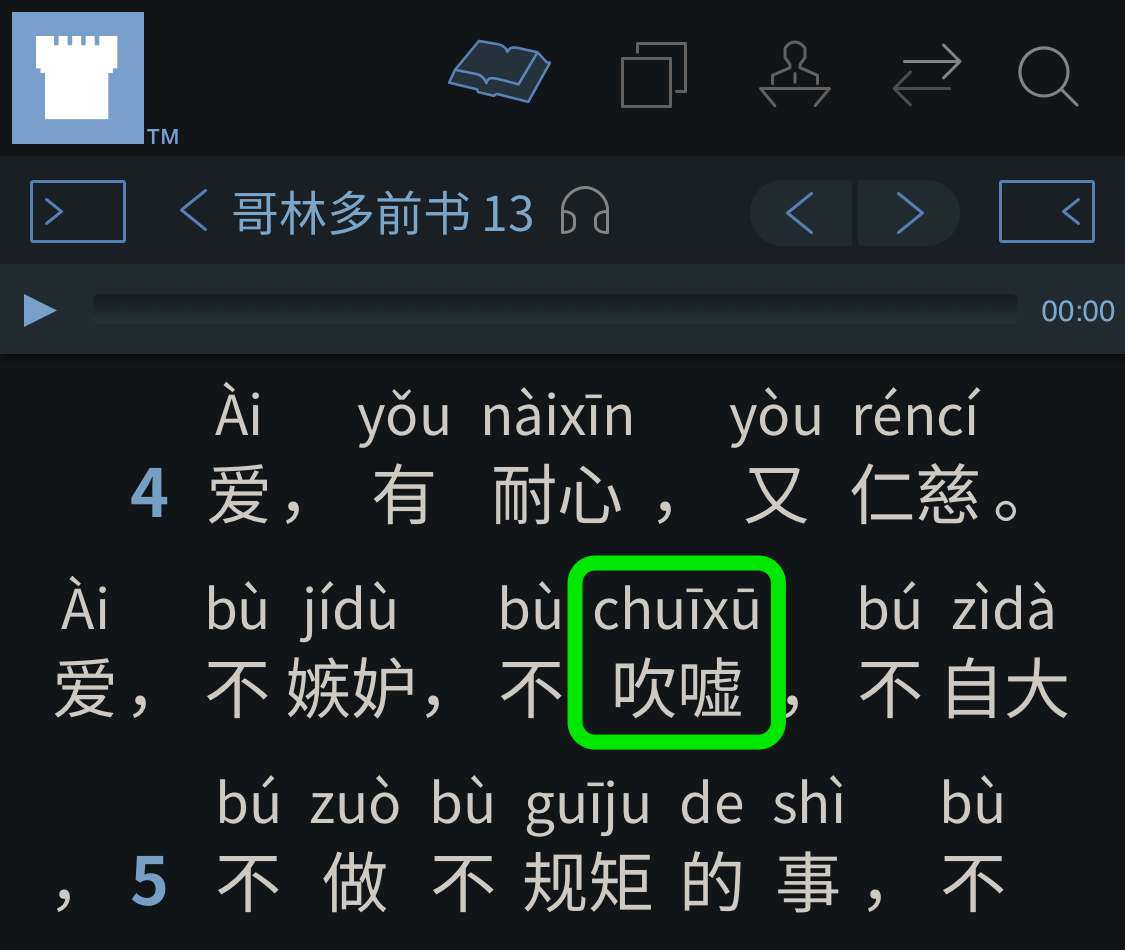chuīxū (chuī·xū {puff → [boast; brag]} · {sigh → [praise]} → [boast; brag; lavishly praise oneself or others] 吹嘘 吹噓) ← Tap/click to show/hide the “flashcard”
[Notes: Tap/click on a Pīnyīn (Pīn·yīn {Piecing Together of} · Sounds → [Pinyin] 拼音) expression to reveal its “flashcard”; tap/click on a “flashcard” or its Pīnyīn (Pīn·yīn {Piecing Together of} · Sounds → [Pinyin] 拼音) expression to hide the “flashcard”. 📖 📄 📘 icons mean 📖 Reveal All, 📄 Reveal Advanced, and 📘 Reveal None re all the “flashcards” in the heading, paragraph, etc. that they are placed at the beginning of.]
I have long especially liked 1 Corinthians 13. It contains counsel on what really does and doesn’t matter in life, an extensive description and definition of the most important kind of love, and a sublime discussion about the need to become complete, mature, as a person. As these apply to life in general, so too do they apply to our lives as Mandarin field language learners.
As Mandarin field language learners, it can benefit us greatly to consider what we can learn from 1 Corinthians 13, and along the way, we can also consider some of the Mandarin expressions used in that chapter in the current version of the Mandarin New World Translation Bible (nwtsty).
Tooting Your Own Horn?
This week’s MEotW, “chuīxū (chuī·xū {puff → [boast; brag]} · {sigh → [praise]} → [boast; brag; lavishly praise oneself or others] 吹嘘 吹噓)”, is used in verse 4 (WOL) of 1 Corinthians 13:

(Dark mode for the Watchtower ONLINE LIBRARY (WOL) website, as shown in the above image, can be enabled in the Safari web browser by using the Noir Safari extension. Other web browsers may also have extensions with similar functionality.)
For comparison, here are the current English and Pīnyīn (Pīn·yīn {Piecing Together of} · Sounds → [Pinyin] 拼音) Plus renderings of 1 Corinthians 13:4:
Love is patient and kind. Love is not jealous. It does not brag, does not get puffed up,
Pīnyīn (Pīn·yīn {Piecing Together of} · Sounds → [Pinyin] 拼音) Plus:
📖 📄 📘 Ài (love 爱 愛), yǒu (has 有) nàixīn (nài·xīn {being (of/with) enduring} · heart → [patience] 耐心), yòu (also 又) réncí (rén·cí {is kind} 仁慈). Ài (love 爱 愛), bù (not 不) jídù ({is jealous} 嫉妒), bù (not 不) chuīxū (chuī·xū {does puff → [does brag]} · {does sigh → [does praise]} → [does brag] 吹嘘 吹噓), bú (not 不) zìdà (zì·dà {(does consider) self} · {to be big → [to be great]} 自大),
The “chuī (blow; puff [→ [play (a wind instrument) | boast; brag | flatter | break off; break up; fall through]] 吹)” in “chuīxū (chuī·xū {puff → [boast; brag]} · {sigh → [praise]} → [boast; brag; lavishly praise oneself or others] 吹嘘 吹噓)” literally means “blow” or “puff”. For example, it’s used this way in “chuīhào (chuī·hào blow · {brass wind instrument} 吹号 吹號)”, which means “blow a brass instrument”, such as a trumpet. In “chuīxū (chuī·xū {puff → [boast; brag]} · {sigh → [praise]} → [boast; brag; lavishly praise oneself or others] 吹嘘 吹噓)”, “chuī (blow; puff [→ [play (a wind instrument) | boast; brag | flatter | break off; break up; fall through]] 吹)” is used to effectively mean “boast” or “brag”, kind of a Mandarin version of “toot your own horn”.
The “xū (sigh; {breathe out slowly/gently} [→ [praise]] 嘘 噓)” in “chuīxū (chuī·xū {puff → [boast; brag]} · {sigh → [praise]} → [boast; brag; lavishly praise oneself or others] 吹嘘 吹噓)” literally means “sigh” or “breathe out slowly/gently”. It can be used to effectively mean “praise”, and in this week’s MEotW, it’s evidently used to mean “praise oneself”.
Characters for the Bragging Rights?
A while ago, a young brother said to me that he felt that Chinese characters may be a test for us. I suppose he meant that characters may test our resolve and determination to serve Jehovah in spite of the presumably unavoidable difficulties presented by them. I replied to him that I think characters help show whether we are serving God in the Mandarin field out of pride, or out of love.
Why did I say that? Well, the truth is that, especially now, and more and more so as time goes on, the difficulties traditionally presented to us Mandarin field language learners by Chinese characters are usually avoidable—much of the organization’s core published Mandarin material is now available with Pīnyīn (Pīn·yīn {Piecing Together of} · Sounds → [Pinyin] 拼音), and more and more of its material is becoming available with Pīnyīn (Pīn·yīn {Piecing Together of} · Sounds → [Pinyin] 拼音) as time goes on. Also, more and more unofficial material with Pīnyīn (Pīn·yīn {Piecing Together of} · Sounds → [Pinyin] 拼音) is also becoming available.
So, if a Mandarin field language learner uses characters rather than Pīnyīn (Pīn·yīn {Piecing Together of} · Sounds → [Pinyin] 拼音), it is more and more becoming a choice, not a necessity. When faced with this choice of writing systems, pride will cause one to gravitate towards choosing the system that has difficulties—even if they are unnecessary and avoidable—that one can brag about overcoming, and that brings with it widespread social and cultural prestige that one can bask in. As Lǔ Xùn ((Lǔ Stupid; Rash (surname) 鲁 魯) (Xùn Fast; Quick; Swift 迅) (pen name of Zhōu Shùrén, the greatest Chinese writer of the 20th cent. and a strong advocate of alphabetic writing)) explained:
In addition to the limitations of social status and economic means, our Chinese characters present another high threshold to the masses: their difficulty. If you don’t spend ten or so years on them, it’s not easy to cross this threshold alone. Those who cross over it are the scholar-officials, and these same scholar-officials do their utmost to make writing as difficult as possible because it makes them especially dignified, surpassing all other ordinary scholar-officials. …
…If the characters were easy to recognize and everybody could master them, then they would not be dignified, and the scholar-officials would lose their dignity along with them.
So, one of the main reasons why characters are the way they are, and why the Chinese people of the world in general have stuck with characters even though much simpler and more reasonable systems like Zhùyīn (Zhù·yīn {Annotating of} · Sounds → [Zhuyin] 注音 註/注音) and Pīnyīn (Pīn·yīn {Piecing Together of} · Sounds → [Pinyin] 拼音) have been around for decades, boils down to pride. Chinese people may show pride in different ways than Westerners are used to, but, to paraphrase Forrest Gump, “proud is as proud does”. Does one keep using an old, overly complex system that one’s ancestors invented and that one has invested much time and effort into, even though a new system has become available that is objectively much simpler and better, and even though lives are at stake? That’s very evidently foolish human pride in action. If a Mandarin field language learner adopts the possibly Christendom-derived attitude of “when in Rome, do as the Romans do” when it comes to characters, then that one will generally be following what turns out to be a prideful course.

Why keep bashing your head against the Great Wall of characters when Pīnyīn (Pīn·yīn {Piecing Together of} · Sounds → [Pinyin] 拼音) makes available a way around it? When all is said and done (and written and read), could it be that the reason many do so boils down to pride?
Choices, Consequences
Of course, some situations call for a nuanced view. For example, one may still encounter situations in the Mandarin field in which certain material is only available in characters, so it’s still the practical course for one to learn as many characters as one reasonably can. However, what writing system does one choose to use when one can, and why?
Also, some in the Mandarin field have already been learning characters for so long that they can already recognize most of the ones they encounter, most of the time. So, such ones may feel that they may as well continue to struggle on with characters. However, with the inhuman number and complexity of characters, unfamiliar characters may still occasionally ambush even highly-experienced native Mandarin-speakers, let alone Mandarin field language learners. Also, even the best of us are still human, so we are all susceptible to occasionally being struck by character amnesia because of the aforementioned inhuman number and complexity of the characters.
Even more seriously, as even the young brother mentioned above acknowledged, experience shows that those who focus on learning characters often end up neglecting their Mandarin speech. This can, and often does, result in their not being able to speak Mandarin very powerfully or persuasively when trying to preach to or teach Mandarin-speaking people. However, linguistics (language science) and the Bible itself both testify that being able to “use speech that is easily understood” is a primarily important requirement in the preaching and teaching work that God has assigned to us.—1 Corinthians 14:8–11.
“Love…Does Not Brag”
In contrast to the prideful course chosen by many in the world, and perhaps unwittingly adopted by some in the Mandarin field, love will move one to, when possible, use the system that through its simplicity and elegance enables one to serve Jehovah and one’s Mandarin-speaking neighbours better, faster, regardless of how it is still often looked down on in the traditional popular culture. As the scripture says, “ài (love 爱 愛)…bù (not 不) chuīxū (chuī·xū {does puff → [does brag]} · {does sigh → [does praise]} → [does brag] 吹嘘 吹噓)”.—1 Corinthians 13:4 (WOL, Pīnyīn (Pīn·yīn {Piecing Together of} · Sounds → [Pinyin] 拼音) Plus).